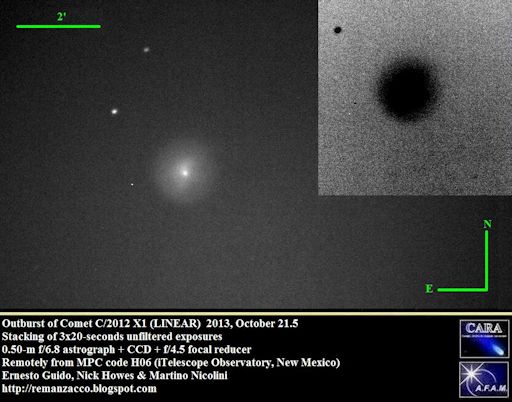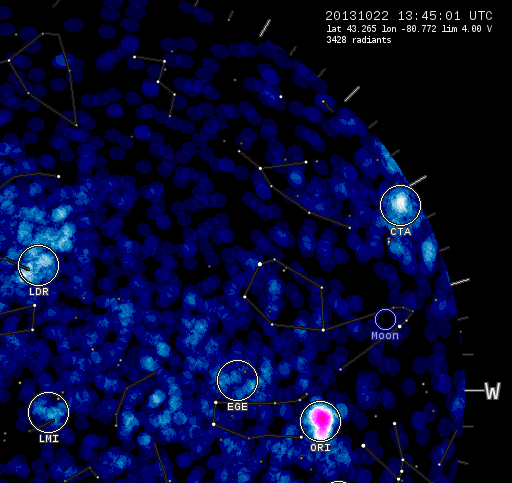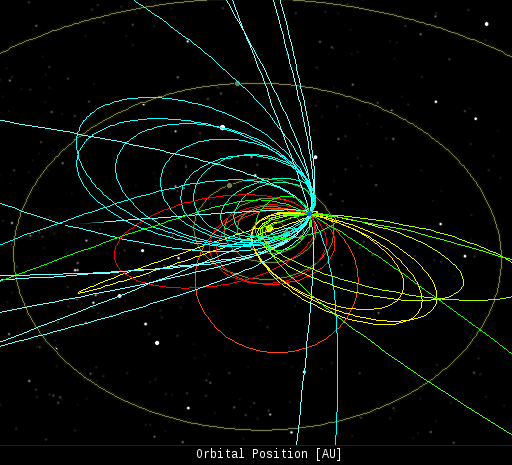CHANCE OF FLARES: Fast-growing sunspot AR1875 (movie) has developed a 'beta-gamma-delta' magnetic field that harbors energy strong explosions. NOAA forecasters estimate a 30% chance of M-class solar flares and a 5% chance of X-flares on Oct. 22nd. Solar flare alerts: text, voice.
COMET EXPLOSION: Almost 450 million km from Earth, Comet C/2012 X1 (LINEAR) has exploded. Amateur astronomers are reporting a 150-fold increase in the comet's brightness on Oct. 20th, and the comet's atmosphere or "coma" now resembles that of exploding Comet 17P/Holmes in 2007. Using a remotely-controlled 0.5 meter telescope in New Mexico, European observers Ernesto Guido, Martino Nicolini and Nick Howes took this picture of the spherical explosion on Oct 21st:
"The predicted magnitude of the comet, pre-outburst, was about +14," says Guido. "Now it is close to +8.5." This is below the threshold for naked-eye visibility, but bright enough for backyard telescopes equipped with digital cameras.
Prompted by the reports of Guido et al, Romanian amateur astronomer Maximilian Teodorescu observed the comet on Oct. 22nd, confirming its brightness and spherical structure: image. "It looked exactly like Comet Holmes back in 2007," says Teodorescu.
Located in the constellation Coma Berenices, Comet LINEAR X1 rises in the east about an hour before the sun. The low altitude of the comet in morning twilight is a challenge. "I could not see the comet through the eyepiece of my 4.5 inch refracting telescope," adds Teodorescu, "but the camera detected it easily enough." The comet could become brighter in the days ahead as its coma expands. Monitoring is encouraged. Resources: 3D orbit, ephemeris, sky map.
ORIONID METEOR SHOWER--UPDATE: The Canadian Meteor Orbit Radar (CMOR) is still detecting echoes from Orionid meteors. This means Earth is still inside a stream of debris from the shower's parent comet, Halley. A CMOR sky map made at 13:45 UT on Oct. 22nd shows the Orionid radiant (ORI) clearly active:
Forecasters expected the shower to peak on Oct. 21st with about 20 meteors per hour. However, Halley's debris stream is so broad that Orionid activity has spilled into Oct. 22nd. If you're up before sunrise, be alert for meteors! [meteor radar] [sky map]
Realtime Space Weather Photo Gallery
Realtime Comet ISON Photo Gallery
| All Sky Fireball Network |
NEW: Every night, a network of NASA all-sky cameras scans the skies above the United States for meteoritic fireballs. Automated software maintained by NASA's Meteoroid Environment Office calculates their orbits, velocity, penetration depth in Earth's atmosphere and many other characteristics. Daily results are presented here on Spaceweather.com.
On Oct. 22, 2013, the network reported 38 fireballs.
(22 sporadics, 12 Orionids, 4 southern Taurids)
In this diagram of the inner solar system, all of the fireball orbits intersect at a single point--Earth. The orbits are color-coded by velocity, from slow (red) to fast (blue). [Larger image] [movies]
| Near Earth Asteroids |
Potentially Hazardous Asteroids (PHAs) are space rocks larger than approximately 100m that can come closer to Earth than 0.05 AU. None of the known PHAs is on a collision course with our planet, although astronomers are finding new ones all the time.
Recent & Upcoming Earth-asteroid encounters:
| Asteroid |
Date(UT)
|
Miss Distance
|
Size
|
| 2013 UB |
Oct 19
|
1.6 LD
|
20 m
|
| 2000 DK79 |
Nov 10
|
49.1 LD
|
3.0 km
|
| 2011 JY1 |
Nov 13
|
8.2 LD
|
57 m
|
| 2001 AV43 |
Nov 18
|
3 LD
|
52 m
|
| 2010 CL19 |
Nov 25
|
37.6 LD
|
1.3 km
|
| 2013 NJ |
Nov 26
|
2.5 LD
|
190 m
|
| 2011 YD29 |
Dec 28
|
6.1 LD
|
24 m
|
| 2007 SJ |
Jan 21
|
18.9 LD
|
1.9 km
|
Notes: LD means "Lunar Distance." 1 LD = 384,401 km, the distance between Earth and the Moon. 1 LD also equals 0.00256 AU. MAG is the visual magnitude of the asteroid on the date of closest approach. ![]()

Solar wind
speed: 330.7 km/sec
density: 3.8 protons/cm3
explanation | more data
Updated: Today at 1507 UT
X-ray Solar Flares
6-hr max: C3 1457 UT Oct22
24-hr: M1 0022 UT Oct22
explanation | more data
Updated: Today at: 1500 UT
![]()
Daily Sun: 22 Oct 13
Sunspot AR1875 poses a growing threat for X-class solar flares. Credit: SDO/HMI
![]()
Sunspot number: 179
What is the sunspot number?
Updated 22 Oct 2013
Spotless Days
Current Stretch: 0 days
2013 total: 0 days (0%)
2012 total: 0 days (0%)
2011 total: 2 days (<1%)
2010 total: 51 days (14%)
2009 total: 260 days (71%)
Since 2004: 821 days
Typical Solar Min: 486 days
Update 22 Oct 2013
The Radio Sun
10.7 cm flux: 136 sfu
explanation | more data
Updated 22 Oct 2013
![]()
Current Auroral Oval:
Switch to: Europe, USA, New Zealand, Antarctica
Credit: NOAA/POES
![]()
Planetary K-index
Now: Kp= 1 quiet
24-hr max: Kp= 2 quiet
explanation | more data
Interplanetary Mag. Field
Btotal: 8.0 nT
Bz: 3.5 nT north
explanation | more data
Updated: Today at 1506 UT
![]()
Coronal Holes: 22 Oct 13
There are no large coronal holes on the Earthside of the sun. Credit: SDO/AIA







